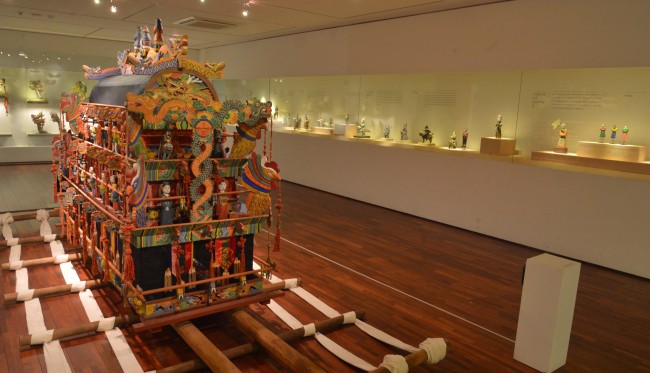Kokdu Museum embraces time-honored funeral rituals “Kokdu” are small figurines carved from pine wood that were traditionally used during Joseon-period funeral rituals. These wooden figurines not only decorated the funeral biers but created a means of consoling the spirit of the deceased.
The figures, which average around 23 cm to 33 cm in height, were there to influence not only the dead, but also the living by providing one with the opportunity to contemplate the meaning of life, death and the universe, and offering solace to the mourners making the figurines or those carrying the bier.
 |
A collection of modern kokdu is on display. ( Lee Sang-sub/The Korea Herald) |
Kokdu Museum director Kim Ock-rang began collecting kokdu after discovering the cultural value of the figures in the early 1970s when nobody else had paid any attention.
“At that time there were a lot of stores selling antiques. I came to see in there a piece of kokdu left abandoned in a corner, wrapped in an unsightly sack. It was a woman kokdu wearing a green jacket and a crimson skirt that looked as though it was holding up its right hand.”
At that moment, she said, she felt inspired to preserve this part of Korean history.
Since then she has been collecting kokdu one by one, and has currently amassed a collection of more than 20,000 pieces.
Examples of human-figured kokdu include: noblemen, warriors, monks, sorceresses, women, servants and children. Animal figures often include dragons, phoenixes, unicorn-lions, tigers and horses. Plant figures include the peony, lotus and pine tree.
There are four different categories of kokdu, according to Kokdu Museum curator Kim Hyang-bin.
“Guides assisted travelers on their journey to the other side; guards were the protectors; caregivers providing the soul with nurturing; and entertainers gave joy and good thoughts to the deceased,” she said.
 |
A funeral bier, used to carry the deceased to the burial site, is decorated with kokdu to bring spiritual guidance. (Lee Sang-sub/The Korea Herald) |
Kokdu were placed around the funeral biers transporting bodies to burial sites as symbolic accompaniments, blessing the deceased who were leaving this world for another. The figurines have become a symbol of Korea’s traditional funeral rites.
“Kokdu are meant to give comfort and companionship while traveling together,” said curator Kim.
Guides, guards, caregivers, entertainersThe traveling soul was thought to get lost along the way; and once lost, unexpected occurrences can happen. The first type of kokdu safely guides these travelers, keeping them out of confusion, and opening to them a new world.
People once believed that the deceased still remain in the area between the “already” and the “yet.” The guardian kokdu protects the traveler through his journey to the next life. These figurines’ faces and gestures were carved to look tough and they are even equipped with weapons.
The kokdu that lend help to a traveler remain quiet and poised. They represent a sense of a mother’s nurturing and peace, which is why the faces of these kokdu were often bright and pure.
These kokdu were intended to rid the sadness and emptiness of traveling alone. The entertainer kokdu were carved out playing music and laughing in order to spread joy to both the deceased and their loved ones.
Dragon and the phoenix
The majority of the animal-shaped kokdu are of dragons and phoenixes. Dragons symbolized the king, the highest of powers. Their role was to protect the funeral bier and the deceased from evil spirits. Traditional dragon kokdu were painted blue and yellow, which were meant to symbolize the power of water and earth, respectively. The images of fire-breathing dragons were said to embrace a feeling of awe in humans because they move freely and in control and represented the ultimate sense of superiority.
Birds were seen as free from all worldly restrictions. The phoenix represented the deceased’s departure from this world to the after life. The Phoenix kokdu were a symbol of transcendence and flight, and the crests and wings of the bird, which look like burning flames, were seen as the guiding signs for travelers who sought freedom and comfort.
By Julie Jackson (
juliejackson@heraldcorp.com)








![[Today’s K-pop] Blackpink’s Jennie, Lisa invited to Coachella as solo acts](http://res.heraldm.com/phpwas/restmb_idxmake.php?idx=644&simg=/content/image/2024/11/21/20241121050099_0.jpg)
